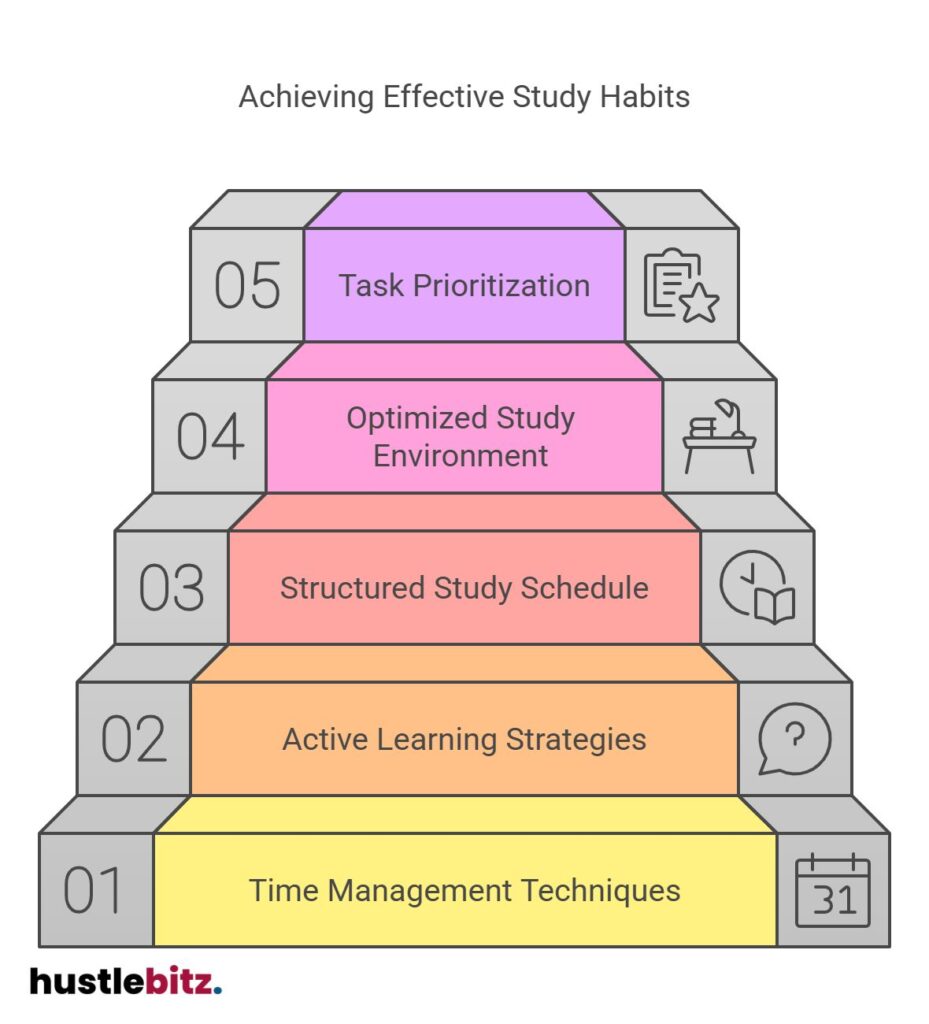To ace your studies, students should adopt tailored productivity hacks. Time management is crucial; utilize techniques like time blocking and goal tracking to enhance focus. Create an effective study schedule that includes specific goals and break intervals. Engage in active learning methods such as self-quizzing and peer teaching to deepen understanding. Prioritize tasks by assessing their urgency, and eliminate distractions through digital detox and structured study sessions. Optimizing your study environment with ergonomic furniture and minimal clutter can also boost concentration. For further insights into mastering your academic journey, explore more strategies to elevate your productivity.
Key Takeaways
- Implement time management techniques like time blocking and goal tracking to enhance focus and reduce procrastination.
- Utilize active learning strategies such as self-quizzing and peer teaching to deepen understanding and retention of material.
- Create a structured study schedule with defined study blocks, specific goals, and regular breaks to maintain energy and motivation.
- Optimize your study environment with ergonomic furniture, ambient lighting, and minimal distractions to enhance concentration and productivity.
- Prioritize tasks using frameworks to focus on high-impact activities and minimize distractions through techniques like the Pomodoro Technique and app blockers.

Importance of Time Management

Effective time management is crucial for students, as it not only enhances academic performance but also fosters a balanced lifestyle. By implementing strategies such as time blocking and deadline setting, students can allocate specific periods for study, ensuring that they remain focused and productive. This structured approach promotes routine consistency, which is essential for developing effective study habits.
Goal tracking plays a significant role in time management by allowing students to monitor their progress and adjust their strategies accordingly. By setting clear objectives, students can avoid procrastination and maintain motivation.
Energy management is another critical aspect; understanding when they are most alert can help students schedule demanding tasks during peak productivity hours.
Self-discipline techniques, like breaking tasks into smaller, manageable segments, can further enhance focus and reduce feelings of overwhelm. Flexibility adaptation is also important; students should be prepared to revise their plans when unexpected challenges arise. This adaptability helps them stay on track without sacrificing their well-being.
Moreover, engaging with accountability partners can significantly bolster time management efforts. These partners provide support, encouragement, and a sense of responsibility, which can enhance motivation and adherence to routines.
Ultimately, effective time management leads to stress reduction, enabling students to navigate their academic responsibilities while maintaining a healthy work-life balance. By prioritizing these strategies, students can cultivate a productive academic environment that promotes success both in their studies and personal lives.
How to Create an Effective Study Schedule

Creating an effective study schedule builds on the principles of time management, allowing students to allocate dedicated time for each subject while balancing their overall academic and personal commitments. To create a schedule that maximizes productivity, students should incorporate study blocks that clearly define periods for focused learning. Setting specific goals for each block enhances time allocation and allows for measurable progress tracking.
Flexibility is also crucial; life can be unpredictable, and a well-structured schedule should include break intervals to maintain energy and focus. Consider incorporating daily routines that seamlessly integrate study sessions with leisure activities. Subject rotation can prevent fatigue and keep motivation high, ensuring that students remain engaged with diverse topics.
Collaborating with accountability partners can enhance commitment to the schedule, as sharing goals fosters a sense of responsibility. Regular review sessions should be planned to reinforce learning and assess progress, enabling students to adjust their strategies as needed.
Here’s a simple example of how to structure a study schedule:
| Day | Subject Focus | Study Block Duration |
| Monday | Mathematics | 2 hours |
| Tuesday | History | 1.5 hours |
| Wednesday | Science | 2 hours |
Incorporating these elements can transform a study schedule from a mere list of tasks into a dynamic tool for success, helping students navigate their academic journey more effectively.
Use Active Learning Techniques

Active learning techniques significantly enhance student engagement and retention of information by encouraging participation and critical thinking during the learning process.
These techniques, such as active recall and self-quizzing, foster a deeper understanding of material by prompting students to retrieve information actively, rather than passively consuming it.
Peer teaching is another effective strategy, where students explain concepts to one another, reinforcing their own understanding while clarifying doubts in their peers. Complementing this with spaced repetition ensures that information is revisited at intervals, optimizing long-term retention.
Concept mapping aids in visualizing relationships between ideas, facilitating a structured approach to problem-solving. The incorporation of multimedia resources and interactive simulations can further enrich the learning experience, catering to diverse learning styles and making complex concepts more accessible.
Group discussions allow for the exchange of ideas, promoting collaborative learning and critical thinking. Engaging in reflective practices encourages students to assess their understanding and identify areas for improvement.
Collectively, these active learning techniques not only improve academic performance but also instill essential skills such as critical thinking and adaptability. By integrating these methods into their study routines, students can transform their educational experience from passive absorption to active engagement, ultimately achieving greater success in their studies.
The Power of Prioritization: Tackling Your Most Important Tasks First
Prioritizing tasks is essential for students, as it enables them to focus on their most important responsibilities and manage their time efficiently.
Effective task identification begins with a clear understanding of academic goals, allowing students to engage in strategic goal setting. By assessing the urgency of each task, students can determine which assignments warrant immediate attention and which can be scheduled for later.
Daily planning becomes an invaluable practice when students incorporate decision-making frameworks that prioritize high-impact tasks. One effective method is time blocking, where specific periods are allocated to complete prioritized assignments, thus enhancing productivity.
Adopting an essentialism approach helps students concentrate on what truly matters, eliminating distractions and unnecessary activities that dilute their efforts.
In some cases, task delegation can also be beneficial. Collaborating with peers on group projects allows students to divide responsibilities based on individual strengths, fostering a more efficient workflow.
Utilizing productivity tools such as digital planners or task management apps can further streamline this process, providing visual cues and reminders to keep students on track.
Effective Note-Taking Strategies for Better Retention

Building on the importance of effective time management, mastering note-taking strategies can significantly enhance students’ retention of information and overall academic performance. A variety of techniques exist that cater to different learning styles, enabling students to find a method that resonates with them.
Visual note taking is particularly effective for visual learners, as it incorporates diagrams and images to represent information. Mind mapping and concept mapping are two methods that foster a deeper understanding by visually connecting ideas.
For those who prefer structured formats, the Cornell method offers a systematic approach, allowing students to divide their notes into cues, notes, and summaries.
Digital tools can further augment these traditional techniques. Applications for audio notes enable students to capture lectures verbatim, ensuring no critical information is overlooked. Additionally, summarization techniques can help distill large volumes of information into manageable chunks, facilitating easier review.
Color coding is another powerful strategy that can enhance memory. By assigning different colors to various themes or subjects, students can create an organized visual hierarchy in their notes. Structured outlines also promote clarity, organizing information in a way that highlights relationships and hierarchies.
Lastly, incorporating flashcard systems into study routines can reinforce retention through active recall. By blending these diverse note-taking strategies, students can optimize their learning processes, ultimately leading to improved academic outcomes.
Managing Distractions: Staying Focused in a Digital World
As students navigate the challenges of a digital world, effectively managing distractions is crucial for maintaining focus and enhancing productivity. The prevalence of digital devices introduces numerous distraction triggers that can disrupt study sessions, making it essential to implement effective strategies. One popular method is the concept of a digital detox, which encourages students to disconnect from their devices for specific periods, allowing them to concentrate more fully on their studies.
Incorporating focus techniques, such as the Pomodoro Technique, can further enhance productivity by structuring study time into manageable intervals with scheduled study breaks. Mindfulness practices, such as deep breathing or meditation, can also help students remain present and centered, reducing susceptibility to distractions.
To minimize interruptions from technology, students can utilize app blockers that restrict access to distracting sites and applications during study hours. Setting social media limits is another effective way to reduce temptation and maintain focus. Additionally, organizing tasks through task batching—grouping similar activities together—can streamline the study process and minimize the cognitive load.
Environmental cues play a significant role in attention management; creating a designated study space can signal the brain to focus. By being aware of personal distraction triggers, students can take proactive steps to mitigate their effects, ultimately fostering a more productive learning environment.
Through the combination of these strategies, students can cultivate an atmosphere conducive to academic success in an increasingly distracting digital landscape.
Building a Study Environment That Boosts Concentration

Creating a study environment that minimizes distractions can significantly enhance concentration and overall academic performance. A well-designed study space is essential for fostering focus and productivity.
Begin by selecting an area dedicated solely to studying, free from interruptions. Ambient lighting plays a crucial role; opt for soft, warm lights that reduce eye strain and create a calming atmosphere.
Noise control is paramount; consider using noise-canceling headphones or white noise machines to block out distracting sounds. Comfortable furniture is equally important; invest in an ergonomic chair and desk that support your posture during long study sessions. Aim for minimal clutter on your study surface to reduce visual distractions, allowing your mind to concentrate on the task at hand.
Incorporating inspirational decor can also enhance motivation—consider hanging motivational quotes or artwork that resonates with your academic goals. Additionally, technology integration, such as productivity apps or digital planners, can streamline your personal organization and keep you on track.
Understanding color psychology can further improve your study environment; for instance, blue hues may promote calmness, while yellow can inspire creativity. Lastly, adding plants not only beautifies your space but also brings the benefits of improved air quality and reduced stress.
Final Thoughts
Mastering productivity as a student requires a blend of effective time management, active learning techniques, and a well-structured study environment. By prioritizing tasks, managing distractions, and optimizing your study space, you can significantly boost your focus and academic performance. Remember, productivity is not just about working harder but also about working smarter—finding the right balance and using strategies that align with your personal learning style. With these tools and techniques in hand, you’ll be better equipped to ace your studies and achieve your academic goals. Stay consistent, stay focused, and success will follow.




